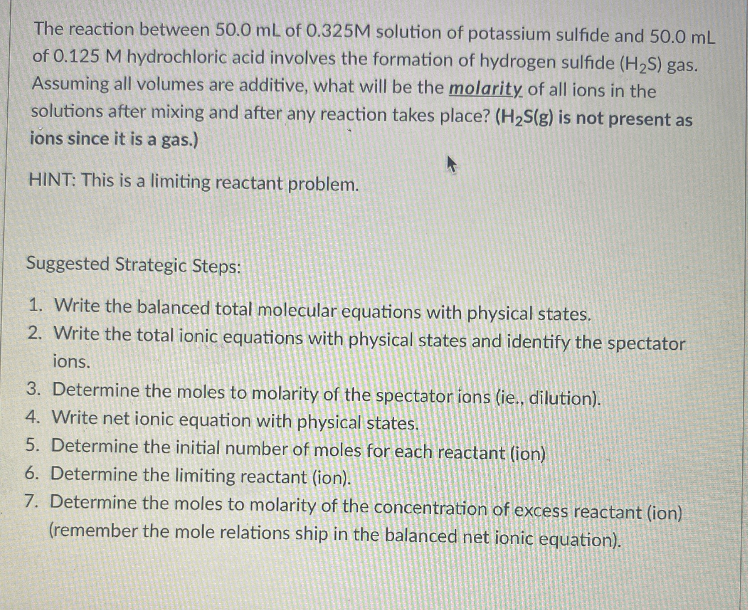The reaction between 50.0 mL of 0.325M solution of potassium sulfide and 50.0 mL of 0.125 M hydrochloric acid involves the formation of hydrogen sulfide (H,S) gas. Assuming all volumes are additive, what will be the molarity of all ions in the solutions after mixing and after any reaction takes place? (H2S(g) is not present as ions since it is a gas.) HINT: This is a limiting reactant problem. Suggested Strategic Steps: 1. Write the balanced total molecular equations with physical states. 2. Write the total ionic equations with physical states and identify the spectator ions. 3. Determine the moles to molarity of the spectator ions (ie., dilution). 4. Write net ionic equation with physical states. 5. Determine the initial number of moles for each reactant (ion) 6. Determine the limiting reactant (ion). 7. Determine the moles to molarity of the concentration of excess reactant (ion) (remember the mole relations ship in the balanced net ionic equation).
The reaction between 50.0 mL of 0.325M solution of potassium sulfide and 50.0 mL of 0.125 M hydrochloric acid involves the formation of hydrogen sulfide (H,S) gas. Assuming all volumes are additive, what will be the molarity of all ions in the solutions after mixing and after any reaction takes place? (H2S(g) is not present as ions since it is a gas.) HINT: This is a limiting reactant problem. Suggested Strategic Steps: 1. Write the balanced total molecular equations with physical states. 2. Write the total ionic equations with physical states and identify the spectator ions. 3. Determine the moles to molarity of the spectator ions (ie., dilution). 4. Write net ionic equation with physical states. 5. Determine the initial number of moles for each reactant (ion) 6. Determine the limiting reactant (ion). 7. Determine the moles to molarity of the concentration of excess reactant (ion) (remember the mole relations ship in the balanced net ionic equation).
Chapter9: Acids, Bases, And Salts
Section: Chapter Questions
Problem 9.109E
Related questions
Question

Transcribed Image Text:The reaction between 50.0 mL of 0.325M solution of potassium sulfide and 50.0 mL
of 0.125 M hydrochloric acid involves the formation of hydrogen sulfide (H,S) gas.
Assuming all volumes are additive, what will be the molarity of all ions in the
solutions after mixing and after any reaction takes place? (H2S(g) is not present as
ions since it is a gas.)
HINT: This is a limiting reactant problem.
Suggested Strategic Steps:
1. Write the balanced total molecular equations with physical states.
2. Write the total ionic equations with physical states and identify the spectator
ions.
3. Determine the moles to molarity of the spectator ions (ie., dilution).
4. Write net ionic equation with physical states.
5. Determine the initial number of moles for each reactant (ion)
6. Determine the limiting reactant (ion).
7. Determine the moles to molarity of the concentration of excess reactant (ion)
(remember the mole relations ship in the balanced net ionic equation).
Expert Solution
This question has been solved!
Explore an expertly crafted, step-by-step solution for a thorough understanding of key concepts.
Step by step
Solved in 6 steps

Recommended textbooks for you


Living By Chemistry: First Edition Textbook
Chemistry
ISBN:
9781559539418
Author:
Angelica Stacy
Publisher:
MAC HIGHER

Chemistry: Principles and Reactions
Chemistry
ISBN:
9781305079373
Author:
William L. Masterton, Cecile N. Hurley
Publisher:
Cengage Learning


Living By Chemistry: First Edition Textbook
Chemistry
ISBN:
9781559539418
Author:
Angelica Stacy
Publisher:
MAC HIGHER

Chemistry: Principles and Reactions
Chemistry
ISBN:
9781305079373
Author:
William L. Masterton, Cecile N. Hurley
Publisher:
Cengage Learning